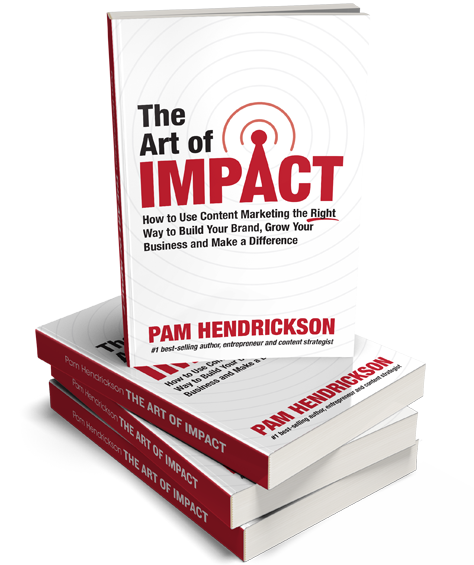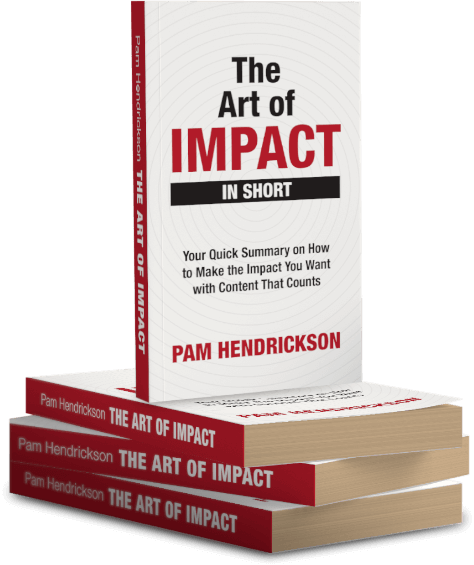You never forget your first time. Speaking, that is. 🙂
It happened like this: Tony Robbins turned to me the night before a big event and said, “Pam, you know this content inside and out. You’re on tomorrow to teach it.” How would you feel? I was nervous beyond belief! And although I did know the content and I delivered a good talk, I wish I knew then what I know now.
You see, since then, I’ve made myself a student of speaking from stage, which is ultimately about communicating with my current and future customers. I’ve learned from some of the best in the arena, and I’ve learned by doing. I’ve sought out and accepted a lot of speaking opportunities in the last few years, driven by a desire to get comfortable on stage and to continually hone this important (and empowering) craft!
Along this journey, I’ve discovered 5 distinctions that make a huge difference in how you communicate with and make an impact on your customers. At times, these distinctions may even mean the difference between getting through to your audience and failing to make a connection. They also give me a huge dose of confidence, so when someone turns to me and says, “You’re on next!” I’m filled with excitement, not fear.
I’ll share these 5 important distinctions with you in this week’s blog. For fun, I’ll also discuss the 3 stages of a speaker in the video to help you evaluate where you are—and where you want to go.
Which level are you on, and what are your goals for yourself? Let me know in the comments! I’d love to hear from you.




These tips can even apply to natural conversation. Thanks Pam 😀
Thanks for the tips Pam. Yes, without empathy and insight you can not make a good connection with your intended audience. Working on that attention span issue is major challenge though. Seems the neuro-synaptic connections are fried 🙂
Stewart – so true. And what I love about it is it’s about attracting folks to your business based on real human connection…with the difficultly of getting people’s attention for more than a few seconds, I think it’s sincere caring and relationship that’s going to keep people around.
Hey Pam, I really liked these 5 tips. Being authentic is key, you’re right, and I am happy to say that when I keynoted the brain-injury conference in Bismarck ND in March that’s what people told me afterwards. And boy did I prepare! I did know who my likely audience, and that was key. I knew there would be a mix of TBI survivors, caregivers & clinicians, and so I addressed each group throughout.
And as far as adapting to twists & turns along the way (like when a few brain-injured people would blurt out comments or unintentionally try to sidetrack the presentation with long-winded personal asides), a true professional takes it all in stride & tactfully presses on, reminding them there would be time at the end for Q&A. In fact I used this quote in my presentation bcz it applies to ALL of us: “It is not the strongest of the species that survives, nor the most intelligent that survives. It is the one that is the most adaptable to change.” (Charles Darwin)
Totally agreed that speaking to an audience of one or many becomes a natural and fluid art of expression. Being awkward in front of a group of people also makes them feel ill at ease and uncomfortable. But when the presentation is smooth and warm and lively, everyone is engaged and eager to hear more.
Speaking is not the easiest of tasks to perform, because thats just what it is – a performance.
But given time, experience, authenticity and empathy for the the audience will certainly make the presentation smooth and over before you know it.
Another tip is to speak to just one person while looking at at each person in the audience, and making them feel as they are the one whom you are addressing. The connection becomes much stronger and the message more detailed and believable.
Thanks Nobby! Wise words from an experienced business person! Agree wholeheartedly that the secret is to keep your presentation (whether to a group of one or many) intimate and personal for each person. Congrats on all the speaking and presenting you’re doing as well.
Thanks Pam for the wonderful review of the book. Presentation skillsworka very important topic for all businesses and industies. As a German teacher and intercultural coach I often discuss presentation skills across cultures. My clients often lead duscussions and teleconferces across different continents and there it is crucial to convey an effective message and be sure that people receive it the right way.
My favorite tip is the one with changing the voice. I think Western cultures tend to speak to quickly and without much alternation in their pitch which can make listening to someone for more than 3 min really boring.
What I further consider important in terms of body language is gestures. We currently live in Italy and I love how Italians involve you in their stories not only by the beautiful language they speak but through their whole expression.
What do you think about asking questions during presentations? While I was listening to the tips, I thought: what is the best way to engage your audience? And I believe by asking a relevant question. The dialogue form always raises people’s attention. Especially if they have the feeling that you might pick someone to answer the question in front of everyone 🙂
Do you have some interesting story in this regard?
Hugs from Italy
These are such great points…keeping in mind an international audience is vital as the Internet allows us to reach people across the globe. I also agree the more enthusiastic and animated you can be, the better (in America, too!) as long as it’s sincere. In addition, it’s important to know gestures in other countries as what’s a perfectly acceptable gesture in one country may be offensive in another so it’s important to research these out as you hone your skills to support an international audience. Finally, your point about questions is such a good one, I’ll devote a future blog post to this. Questions are a really potent way to engage an audience (because nothing you tell them will ever be as powerful as what they tell themselves), the caveat to this, however, is you have to be really careful about when and how you take actual questions from the audience as in the wrong context it can derail your outcomes. I’ll record a blog on this sometime in the next few weeks. Thanks so much for your comments! Grazie Mille! 🙂
Hey Pam – can’t help but think of the time Marie Osmond pees herself onstage and how she and Donny flip into immediate ad-lib mode and turn an embarrassing moment into hilarious audience laughter.
Spot on, be authentic (okay not peeing your pants) connect with the audience and allow them a peak into strengths … and weaknesses.
After all, speaking is a performance with an arc and architecture. We get to hold the audience’s emotions in the palm of our hand and take them through our journey.
Can always count on you for top notch, useful, applicable material. Mille grazie from Boston!
Paula, what a FANTASTIC story! While I wouldn’t wish that on anyone, her response was so elegant—and it shows why she has had such longevity with her career. Being authentic and real…which means acknowledging WHATEVER comes up…is so vital. I agree, it’s probably best not to pee your pants 😉 – and I love your key points here. Very well phrased. Hugs back to Boston – hoping to get back there again this summer (my dad and my brother and his family live there)! Thanks again for your comments!